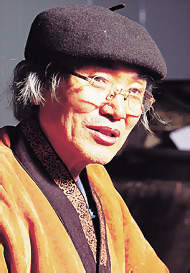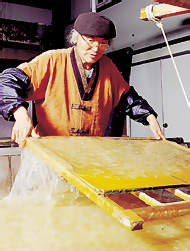| PDF Service | Korean | Japanese | Chinese |
|
|||||||
|
An Old and Beautiful Tradition 
Hanji has many uses, but was mostly used for passing down records, followed by decoration on doors, walls and floors of Korean traditional houses as interior decorating paper. Also hanji was the only material that could control light adequately. Hanji was also used in religious ceremonies as in Korea, culture was strongly influenced by these formal events and hanji was used to record them. White was used for its meaning of cleanness and purity. Hanji was also used for money and art to name only a few.  Hanji has been essential in Korean's living, but since the
popularization of western paper its use has been decreasing. Request for
machine paper, which can be made in less time, has been increasing.
Hanji factories with decreases in requests became hard to find since the
1970s. Jang has been frustrated a few times by economic problems from
the decrease in demand, but hasn't given up making hanji. He first
started making hanji because it was his father's job but now he feels
that he needs to protect it. His aim is to make the best hanji. Now even
his son Jang Yong-woong wishes to keep the family business going. Jang
works in a hanji workroom named 'Jangjibang' in Gapyong, Kyonggido. Here
he makes various kinds of hanji and exports it overseas.
Hanji has been essential in Korean's living, but since the
popularization of western paper its use has been decreasing. Request for
machine paper, which can be made in less time, has been increasing.
Hanji factories with decreases in requests became hard to find since the
1970s. Jang has been frustrated a few times by economic problems from
the decrease in demand, but hasn't given up making hanji. He first
started making hanji because it was his father's job but now he feels
that he needs to protect it. His aim is to make the best hanji. Now even
his son Jang Yong-woong wishes to keep the family business going. Jang
works in a hanji workroom named 'Jangjibang' in Gapyong, Kyonggido. Here
he makes various kinds of hanji and exports it overseas.
(Tel) 031-581-0457 How to Make Hanji Get a year old mulberry between November and February. Steam the mulberry overnight. Peel the bark of mulberry. Dry the peeled bark. Soak the bark in water then peel the outer skin of the bark. Dry the bark again. Soak the Bark in clear and cold water. Put the bark in a pot with lye made from burning straw. Wash off the lye. Pound the bark with a stick then put in water. Make a square shape and dry. (Sourced from WHAT'S ON SEOUL) |
|
||||||||||||||||||||||||||||||||||||||||||||||||||||||
|